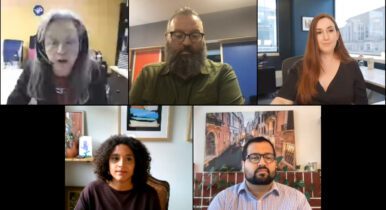This Cycle Proved Campaigns Can Adapt, Now It’s Advocacy’s Turn
Despite the ongoing pandemic, many organizations have been able to virtually convene thousands of individuals to celebrate momentous occasions in politics and government. Some of these monumental changes in event production and messaging underscored the need for innovation in ways that may have gone unnoticed.
From last summer’s national party conventions to the presidential inauguration next month, American ingenuity has led us through systemic shifts in how we participate in major political events.
Despite the ongoing pandemic, many organizations have been able to virtually convene thousands of individuals to celebrate momentous occasions in politics and government. Some of these monumental changes in event production and messaging underscored the need for innovation in ways that may have gone unnoticed.
In a similar vein, the political operations of every organization involved with politics and policy were put to the test. From basic sustainability to finding pathways to campaign and achieve legislative success required an immediate and almost flawless pivot to the new normal brought on by the pandemic.
From spring to early summer, in my role as National Political Director at the U.S. Chamber of Commerce, I was amazed at the number of requests for telephone conversations from candidates running for federal office. We typically meet in person with more than 150 men and women seeking elected federal office during a full cycle and expected those requests to grind to a halt while the nation was reeling from the public health crisis and economies shutting down.
It was inspiring to hear candidates focused on delivering solutions for their would-be constituents in the trying economic climate, to identifying new ways to communicate their vision and raise the resources necessary to compete in a more expensive political arena despite the environment. As those of us who work in politics knew then, no matter the significant shift in our own professional lives, there would be an election, and the show had to go on.
In the business of Washington politics and policy, the changes brought by the pandemic created a seismic shift that pushed every organization to adapt in order to continue delivering for members. Like campaigns, effective issue advocacy organizations aren’t holding off from hosting events (they’re just doing it virtually or in scaled-back, socially distanced settings), making the legislative ask (by phone or Zoom), or launching new digital public opinion programs until there’s a return to normal.
And beyond that, those organizations which are not only surviving but thriving in this moment are thinking bigger and bolder. They’ve identified new ways to be effective while not abandoning the playbook of what makes political and issue advocacy campaigns successful: keeping a clear eye on education and mobilization to bolster the ultimate goal.
As much of the political world now shifts from pure electioneering campaigns to building programs to advance the legislative agendas of their issue-advocacy clients, we must take the best of what was learned this previous political cycle. We faced not only the most tribal environment in modern history but witnessed both sides of the aisle succeed, despite being thrown curveballs from the global pandemic.
Relying on the way things have always been done won’t be enough to achieve success in the public policy arena in 2021 as elected officials begin new legislative sessions in Washington and across the country. Smart, successful issue advocacy campaigns will be built to bolster legislative priorities by adopting the best tactics introduced this year. For example, there were significant shifts this cycle in the way digital advertising was executed as the percentage of Americans receiving news online exploded.
As with any strategic program, the tactics must support the greater goal, but they must also include unique ways to mobilize supporters. At the same time, elected officials need to understand the power of the grassroots support behind those causes. Despite the hope of a return to “normal” in the very near future, effective political and issue advocacy campaigns will never slide back to pre-2020 measures.
Ashlee Rich Stephenson is Vice President and National Political Director at the U.S. Chamber of Commerce.

